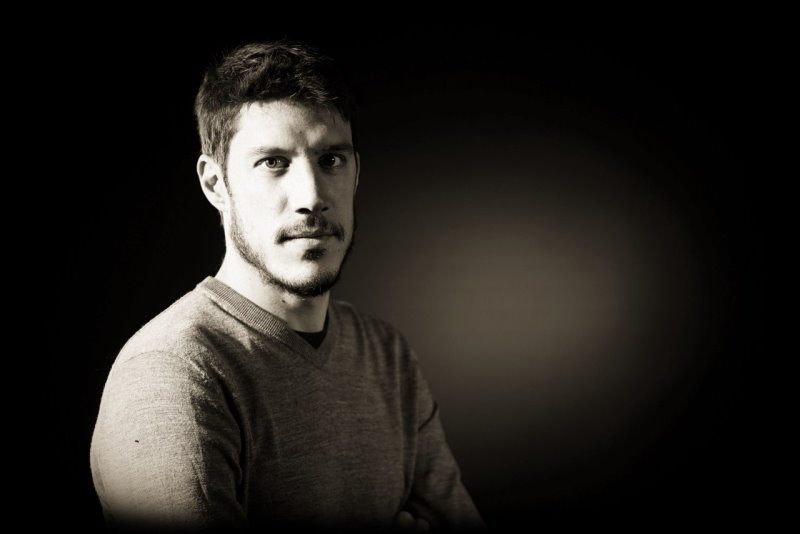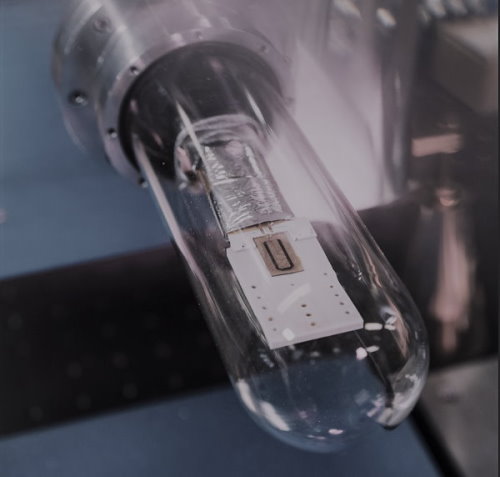
(Super)conducting research into a compact all-in-one antenna
Regular radio antennas can become quite sizeable. The lower the frequency you want to receive, the longer your antenna needs to be. “To be able to pick up the FM signals around 100 MHz, a car antenna has to be about 75 centimeters long – a quarter of the wavelength. Such antennas used to be straight metal rods sticking into the air; in modern vehicles, they’re made to meander around the windshield, for example,” illustrates Juan Trastoy of Thales. “Submarines communicate at much lower frequencies, tens to hundreds of kilohertzes, corresponding to waves of a few kilometers in length. This requires antennas a couple of hundred meters long.”
At the joint lab of Thales and the French National Center for Scientific Research (CNRS), near Paris, Trastoy and his colleagues are looking into alternatives of more manageable proportions. The so-called quantum RF antennas they’re working on are a very promising research avenue. Not much bigger than a milk carton, these devices can pick up a wide range of frequencies, from DC (0 Hz) to 30 GHz. The development hasn’t gone unnoticed, winning an Innovation Award at the recent Euronaval exhibition.

Little fridge
The quantum RF antenna is a receiver only, but an extremely sensitive one. “When a signal comes in, its magnetic signature is picked up as a complex voltage response, which we then convert into a frequency spectrum using a Fourier transform,” summarizes Trastoy. “Not only can we determine the constituent frequencies across a very wide band, and thus identify the type of sending device, but we can also figure out the direction the signal is coming from. And since we’re working with the magnetic component, we don’t suffer from all the distortions in the electric field, like those introduced by a boat itself.”
At the heart of the quantum RF antenna is the superconducting quantum interference device. “Such a SQUID consists of a superconducting loop a few micrometers wide, with a top and a bottom contact and a very thin non-superconducting barrier in each of the sides,” explains Trastoy. “At each barrier, a macroscopic quantum phenomenon occurs, called the Josephson effect. When a current is sent through the loop in the presence of a varying external magnetic field, the interference of both barriers causes a sinusoidal voltage response across the contacts, the period of which is inversely proportional to the loop size – the bigger the loop, the smaller the periodicity of the sine response.”
A quantum RF antenna strings together thousands of SQUIDs of different sizes to form a chain a couple of centimeters long. The devices are combined in such a way that their voltage responses all dip at zero magnetic field while canceling each other out everywhere else. “It creates what’s called an anti-peak around zero. Because of the steep slopes on either side, a tiny variation in the magnetic field will result in a big variation in voltage, allowing for a very accurate measurement of the field – essentially, it’s a highly sensitive magnetometer. SQUID arrays are also known as a superconducting quantum interference filters, or SQIFs. But they’re not filters at all, so I prefer to call them quantum antennas.”
The essential superconducting properties of the SQUIDs require refrigeration to come into force. “The loops are made of a ceramic material called yttrium barium copper oxide, YBCO, which has to be cooled to become superconducting,” Trastoy elaborates. “We don’t have to go all the way down to the milli-kelvin level using huge refrigerators as with quantum computers; for YBCO, 70-90 K suffices, so we only need a small cryostat. Enclosed in this little fridge, which we obtain from Thales Cryogenics in Eindhoven or Toulouse, the complete system is the size of a 20 cm cube.”

Ultra-precision
The potential applications are manyfold. “There’s a business unit in Thales called SIX GTS, specializing in secure information and communication systems. My colleagues there are very interested to replace different antennas aboard submarines, ships or planes with this compact all-in-one device,” Trastoy illustrates. “It would also be a good solution for drones, which can’t carry big antennas.”
The quantum RF antenna is still a work in progress, Trastoy notes. “We’ve demonstrated the principle and built a couple of pretty decent prototypes – I’d put it between technology readiness levels 3 and 4. Being a part of Thales Research & Technology, the corporate research organization, we typically go to TRL 5, at which point the work is transferred to the business units, like SIX GTS or Defense Mission Systems, DMS. They take it from there, all the way to TRL 9. Our total horizon for getting technology mature enough to be included in a product is about ten years.”
One of the main challenges is the production of the SQUID array. “The thousands of superconducting loops and the non-superconducting barriers inside need to respond similarly under all circumstances. The more SQUIDs are out of sync, the bigger the noise. Bearing in mind that the loops are a few microns wide and the barriers are even smaller, measuring only a couple of tens of nanometers, you can imagine the ultra-precision with which they need to be manufactured. To make things even more challenging, YBCO also isn’t the easiest material to process.”
The SQUIDs are fabricated with electron beam lithography. “We use tools from the semiconductor industry, but we’ve adapted the machines and the processes to achieve an extremely homogeneous result across the whole chain,” says Trastoy. “We’re working to further increase the fabrication maturity and achieve the best homogeneity and repeatability with standard semiconductor production equipment and techniques.”
Curiosity
Trastoy’s group is also researching other applications of superconducting materials, including actual filters. “Because of their very low resistance, superconductors have very low dissipation. That makes them very useful for creating resonators. When such a resonator is placed in the proximity of a special electromagnetic transmission line, called a stripline, its resonating frequency is removed from the passing RF signal. The result is a real band-rejection filter, which can be used, for example, to separate overlapping signals from a radar and a satcom system, so that both can be used simultaneously. This technology is more mature, TRL 5, and has in fact already been transferred to Thales DMS.”
“Being able to conduct such advanced research in such a top-notch lab is what makes my job at Thales so much fun,” concludes Trastoy. “I have the financial resources, the facilities and the freedom, within my domain of expertise, to go where my curiosity takes me.”
This article was written in close collaboration with Thales.





